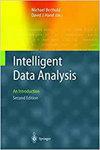利用内隐独立性假设学习有向图形模型
IF 0.8
4区 计算机科学
Q4 COMPUTER SCIENCE, ARTIFICIAL INTELLIGENCE
引用次数: 0
摘要
贝叶斯网络分类器(bcs)为表示概率知识和不确定性推理提供了良好的形式。明确的独立性假设可以有效地减小求解结构学习的np完全问题的搜索空间大小。当在BNC网络拓扑中加入强条件依赖关系时,可以放松独立性假设,而弱条件依赖关系则可能导致条件概率估计的偏差和泛化性能的下降。在本文中,我们提出了k依赖贝叶斯分类器(KDB)的扩展,该分类器通过验证隐含独立性假设的合理性来实现偏差/方差权衡。学习到的鲁棒拓扑中表示的信息依赖关系和概率依赖关系将分别更适合于拟合有标记和未标记的数据。在40个UCI数据集上的综合实验结果表明,与最先进的BNC学习器及其有效变体相比,我们提出的算法在0 - 1损失、均方根误差(RMSE)、偏差和方差方面取得了相当的分类性能。本文章由计算机程序翻译,如有差异,请以英文原文为准。
Exploiting the implicit independence assumption for learning directed graphical models
Bayesian network classifiers (BNCs) provide a sound formalism for representing probabilistic knowledge and reasoning with uncertainty. Explicit independence assumptions can effectively and efficiently reduce the size of the search space for solving the NP-complete problem of structure learning. Strong conditional dependencies, when added to the network topology of BNC, can relax the independence assumptions, whereas the weak ones may result in biased estimates of conditional probability and degradation in generalization performance. In this paper, we propose an extension to the k-dependence Bayesian classifier (KDB) that achieves the bias/variance trade-off by verifying the rationality of implicit independence assumptions implicated. The informational and probabilistic dependency relationships represented in the learned robust topologies will be more appropriate for fitting labeled and unlabeled data, respectively. The comprehensive experimental results on 40 UCI datasets show that our proposed algorithm achieves competitive classification performance when compared to state-of-the-art BNC learners and their efficient variants in terms of zero-one loss, root mean square error (RMSE), bias and variance.
求助全文
通过发布文献求助,成功后即可免费获取论文全文。
去求助
来源期刊

Intelligent Data Analysis
工程技术-计算机:人工智能
CiteScore
2.20
自引率
5.90%
发文量
85
审稿时长
3.3 months
期刊介绍:
Intelligent Data Analysis provides a forum for the examination of issues related to the research and applications of Artificial Intelligence techniques in data analysis across a variety of disciplines. These techniques include (but are not limited to): all areas of data visualization, data pre-processing (fusion, editing, transformation, filtering, sampling), data engineering, database mining techniques, tools and applications, use of domain knowledge in data analysis, big data applications, evolutionary algorithms, machine learning, neural nets, fuzzy logic, statistical pattern recognition, knowledge filtering, and post-processing. In particular, papers are preferred that discuss development of new AI related data analysis architectures, methodologies, and techniques and their applications to various domains.
 求助内容:
求助内容: 应助结果提醒方式:
应助结果提醒方式:


